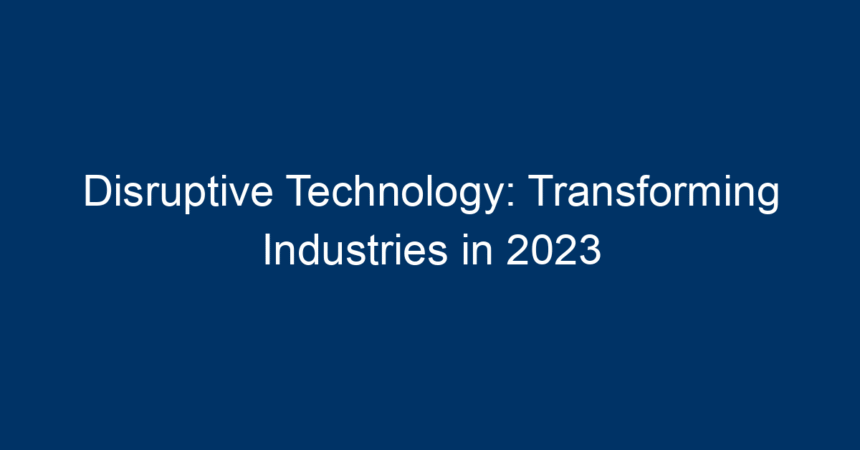In a world where change is the only constant, disruptive technology stands out as a pivotal force reshaping the landscape of various industries. From artificial intelligence (AI) and blockchain to 5G networks and Internet of Things (IoT), the innovations of 2023 present unprecedented opportunities and challenges. This article delves into how these transformative technologies are revolutionizing industries, the implications for businesses, and actionable insights to thrive in this dynamic environment.
What is Disruptive Technology?
Disruptive technology refers to innovations that significantly alter the way industries operate, often displacing established products or services. Unlike sustaining technologies, which improve existing solutions, disruptive technologies create new markets or reshape existing ones. The hallmark of these technologies is their potential to provide greater value, lower costs, or enhanced features that meet the needs of a new customer segment.
Key Characteristics of Disruptive Technology
- Accessibility: Often, disruptive technologies start with simpler applications, making them accessible to a broader audience.
- Affordability: By drastically reducing costs, they provide solutions that appeal to customers who previously could not afford them.
- Innovative Value Proposition: These technologies deliver enhanced functionalities that meet evolving customer needs.
Major Disruptive Technologies in 2023
1. Artificial Intelligence in Business
Artificial Intelligence (AI) continues to be a game changer across industries in 2023. With advancements in machine learning and natural language processing, AI tools enhance decision-making and automate repetitive tasks. Businesses are utilizing AI for:
- Customer Engagement: AI-driven chatbots provide 24/7 customer support, improving user experience and efficiency.
- Predictive Analytics: By analyzing historical data, AI helps businesses forecast trends and customer behavior, enabling proactive strategies.
- Supply Chain Optimization: AI streamlines operations by predicting demand fluctuations and optimizing inventory levels.
2. Blockchain Beyond Cryptocurrency
While blockchain initially gained fame through cryptocurrencies, its applications now extend far into various sectors. In 2023, industries such as healthcare and finance leverage blockchain for:
- Transparency and Security: Immutable records enhance security and reduce fraud, especially in financial services and supply chains.
- Smart Contracts: These self-executing contracts eliminate the need for intermediaries, streamlining transactions and reducing costs.
- Data Management: In healthcare, blockchain helps securely store patient records, ensuring privacy while facilitating easy sharing among authorized entities.
3. Internet of Things (IoT)
The Internet of Things (IoT) refers to the interconnected network of devices that communicate with each other. In 2023, IoT plays a crucial role in enhancing operational efficiency across industries:
- Smart Manufacturing: IoT sensors monitor machinery performance in real-time, predicting maintenance needs and reducing downtimes.
- Connected Homes: Smart home devices allow users to control lighting, heating, and security systems, enhancing convenience and energy efficiency.
- Healthcare Monitoring: Wearables and connected devices facilitate remote patient monitoring, providing healthcare professionals with real-time data.
4. 5G and Its Transformative Impact
The rollout of 5G technology is revolutionizing connectivity, enabling faster data transfer and lower latency. Here’s how 5G is transforming industries in 2023:
- Telemedicine: High-speed networks allow for real-time consultations and remote surgeries, improving access to healthcare.
- Autonomous Vehicles: 5G connectivity supports safe vehicle-to-everything (V2X) communication critical for the development of self-driving cars.
- Smart Cities: Enhanced connectivity drives innovations in urban infrastructure, from traffic management systems to energy-efficient buildings.
5. Augmented Reality (AR) and Virtual Reality (VR)
AR and VR technologies are no longer confined to gaming. They are now disrupting sectors such as education, retail, and real estate by offering immersive experiences:
- Training and Education: Institutions are using AR/VR for simulations and immersive learning environments, enhancing student engagement.
- Virtual Showrooms: Retailers implement AR to allow customers to visualize products in their homes before purchase, revolutionizing the shopping experience.
- Real Estate Tours: Virtual reality provides potential buyers an immersive experience of properties, significantly enhancing the buying process.
Challenges of Embracing Disruptive Technology
While the advantages of disruptive technologies are numerous, they come with challenges:
Resistance to Change
Many organizations struggle to adapt to new technologies due to entrenched mindsets and traditional processes. It’s vital for leadership to foster a culture of innovation that encourages experimentation.
Cybersecurity Risks
With increased connectivity and reliance on technology comes heightened security risks. Businesses must invest in robust cybersecurity measures to protect sensitive data.
Talent Shortage
As industries evolve, the demand for skilled workers in fields like AI, data analysis, and software development continues to rise. Organizations must adapt their talent acquisition and workforce development strategies to meet these needs.
Actionable Insights for Businesses
-
Invest in Continuous Learning: Equip your workforce with the skills needed for emerging technologies. Offer training programs that promote digital literacy and understanding of disruptive technologies.
-
Foster a Culture of Innovation: Encourage experimentation and collaboration within teams. Create an environment where employees feel safe to propose new ideas and challenge the status quo.
-
Strategic Partnerships: Collaborate with tech firms and startups specializing in disruptive technologies. These partnerships can provide valuable insights and accelerate innovation.
-
Stay Informed: Regularly analyze market trends and technological advancements. Staying ahead of the curve ensures that businesses can pivot in response to changes in the industry landscape.
- Customer-Centric Approach: Prioritize understanding the evolving needs and preferences of your customers. Leveraging data analytics can provide insights into customer behavior, enabling tailored offerings.
Conclusion
The landscape of industries is continually evolving, largely driven by disruptive technology. Embracing these innovations can propel businesses to new heights, offering enhanced efficiency, improved customer experiences, and a competitive edge. However, navigating the challenges of adaptation and ensuring cybersecurity are crucial for success. By fostering a culture of innovation, investing in talent, and embracing collaboration, organizations can not only adapt to these changes but thrive amid disruption.
In 2023, it’s essential to be proactive; after all, the future belongs to those who dare to innovate and continue to harness the power of disruptive technologies.




